What they are used for
Records relating to hospitals and health are of great interest, because everyone can relate to experiencing illness. They also have enormous research and study potential in a number of academic subject areas. Some of the major topics touched on by health collections at the University of Nottingham are given below.
Local and Community History
Before the establishment of the National Health Service in 1948, hospitals were self-governing institutions, largely funded by charitable contributions and fees.
They had a very high profile in their local area. Board members and patrons were often members of the aristocracy, or were aldermen, councillors or magistrates. Fundraising events, openings of new buildings or wards, and annual general meetings and accounts were reported in the press in great detail.
Many hospital collections contain albums of newspaper cuttings or photographs recording these events, along with printed appeal booklets and pamphlets designed to inform the public about the work of the hospital, and persuade them to contribute to its work. Lists of subscribers or contributors sometimes exist, giving a good idea of the community of interested people involved with the hospital.
The surviving records are particularly rich for Nottingham General Hospital, which was founded in 1782 and closed in 1992. The Nottingham Eye Hospital, the Nottingham Children's Hospital and the Nottingham Women's Hospital were also prominent local institutions in the late-nineteenth and twentieth centuries.
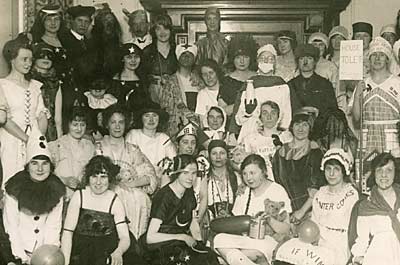
Christmas fancy dress party in the Nurses Memorial Home 1924 [Uhg Ph 3/6/1]
The administration of particular hospitals is recorded most comprehensively in
minute books. Account books can also give an insight into the running of a hospital. The records of Nottingham General Hospital include yearly
accounts from the 1780s. They show relative expenditure on basic provisions such as flour, oatmeal, ale, wine, cheese, and coals, as well as drugs and medicines, salaries, and surgeons' instruments. Most hospital collections include formal annual accounts of income and expenditure which give an idea of the financial costs of providing healthcare. Runs of printed
annual reports are particularly useful in building up a picture of a hospital over time, and are easy to read.
Maps and plans survive in far fewer numbers, but do help to document the changing landscape around hospital sites, and the architecture of new buildings.
In 1948, hospitals began receiving state funding, and responsibility for their strategic administration was transferred to regional health boards. Hospital management committees such as the Nottingham No. 1 Hospital Management Committee became increasingly important in health services administration. Their minutes provide useful information about how local health services were transformed in the latter part of the twentieth century.
Fundraising bodies such as the General Hospital Nottingham Linen Guild and League of Hospital Friends maintained their work after 1948, but shifted their attention to large projects such as the Bicentenary Appeal to fund a Stroke Research Unit, and to the purchase of a hospital minibus. Many of the Nottingham hospitals closed in the 1980s as the new Queen's Medical Centre began absorbing their functions. The reactions of local people to the closures of the hospitals are recorded in letters,
reminiscences and newspaper reports, sometimes found in the hospital collections and sometimes in small collections received directly from individuals.
History of Medicine
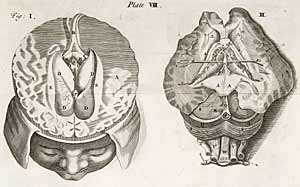
Dissection diagram [Medical Rare Books, QS4.N]
Information about medical conditions and treatments across the centuries is recorded in a wide range of records and collections. Printed books are particularly useful.
The library of the Nottingham Medico-Chirurgical Society contains treatises dating back to the sixteenth century, and the Medical Rare Books collection also contains many interesting volumes. Dr F.H. Jacob, a physician at Nottingham General Hospital from 1901 onwards, compiled a manuscript bibliography of books on medicine, and appended his personal assessment of the merits of each work (MS 447).
Some details about medical treatments can be found in the operations books, patient registers and ward records of the hospital collections. However, access to all patient and clinical records is restricted for a period of 100 years from date of creation due to the confidential information they contain.
At the moment, the majority of such records cannot normally be presented to users due to this closure period. Researchers wishing to use these records should contact the Department and may be given permission under certain conditions.
Papers of medical professionals such as doctors and nurses often contain copies of books or journal articles which they found useful in their work. Their personal correspondence can also reveal details about their day-to-day work, and photographs collected by them show working conditions inside wards.
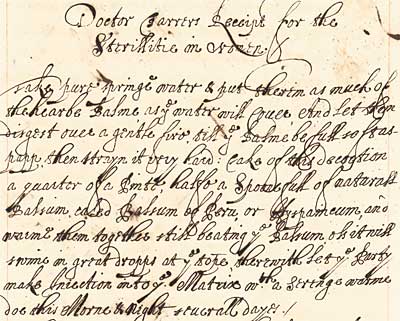
Doctor Farrers Recipe for the Sterillitie in Women; n.d. [1643-1665] [Pw V 90]
The papers of Edward Mason Wrench (1833-1912) are a fascinating source for medical history at home and abroad. He was an Assistant-Surgeon with the 34th Regiment in the Crimean War, and was placed in medical charge of a portion of the hospital at Balaclava in 1854. His papers (Wr and Wre) include extensive correspondence describing the conditions in the Crimea.
The Wrench archive also covers his later life and career as a doctor in Baslow, Derbyshire. His diaries document his medical work with the local population, and also include many ephemeral cuttings and papers relating to wider medical matters.
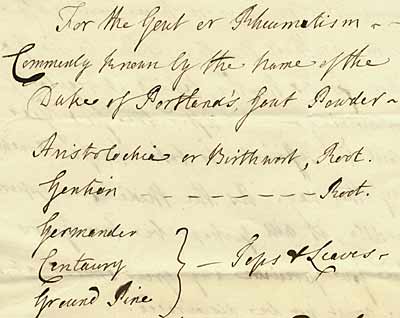
Recipe for gout powder sent by Henrietta Grey, Dowager Countess of Stamford to William Cavendish-Scott-Bentinck, 4th Duke of Portland; c. Aug. 1821 [Pw H 742]
Family and estate collections are a very important source for information on general medical history. Members of aristocratic and gentry families in the sixteenth to eighteenth centuries often wrote detailed letters to each other, and described their symptoms and the treatments they received.
In the years before comprehensive medical services were in place, most people relied on traditional herbal remedies for common conditions. Recipe books often included instructions for medicines as well as food, and examples can be found in the Newcastle (Ne), Portland (Pw), Mellish (Me) and other family collections. Medical prescriptions and apothecaries' bills also survive among the private papers of many families.
History of Nursing Work and Nurses' Training
The Florence Nightingale collection of printed books is another good source for the development of nursing as a profession during and after the Crimean War. A copy of her own Notes on Hospitals, published in 1859, is part of the Nottingham Medico-Chirurgical library collection. References to Miss Nightingale and her work can also be found in correspondence in other collections, particularly the Newcastle Collection (Ne).
Nottingham General Hospital was the location for a large Nurses' Training School established in the early twentieth century, and many records survive in the series Uhg/T. Printed Prospectuses give an outline of the curriculum and are illustrated with photographs showing nurses' accommodation. The Rules expected to be followed by trainee nurses were very strict by today's standards. Lecture notes from the 1920s reveal procedures followed in hospitals at that time.
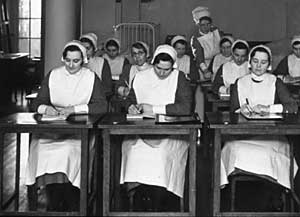
Classroom at Nurses' Memorial Home, Nottingham General Hospital, 1930s [MS 334/5/18]
Similar material has also been acquired by Manuscripts and Special Collections from individual nurses who had trained or worked at the General Hospital. The General Hospital Nottingham Nurses' League
was founded in around 1948, to provide a forum for discussion of professional matters between nurses employed in or trained at the hospital, to provide social contacts, and to raise money to assist elderly and needy members. Records of the League exist in accruals to the Nottingham General Hospital collection, and in a minute book dated 1969-1982 (MS 343).
Some references to nursing elsewhere can be found in the wider collections held by the University. In particular, the Buchanan collection (Bu). contains the journal and photograph album of Meriel Buchanan, the daughter of the British ambassador in St Petersburg. Her mother Lady Georgina took over the organization of a hospital for wounded Russian soldiers in St Petersburg during the First World War, and Meriel Buchanan worked as a nurse there. The work was very distressing, involving the treatment of appalling wounds with little equipment and few supplies.
Family History
Patient admission, discharge and other registers can be useful
biographical sources. Many of the hospital collections also contain records of staff who worked there. Photographs, annual reports and newspaper cuttings can reveal details of the careers of senior medical and nursing staff.
However, access to all patient and clinical records is restricted for a period of 100 years from date of creation due to the confidential information they contain. At the moment, the majority of such records cannot normally be presented to users due to this closure period. Researchers wishing to use these records should contact the Department and may be given permission under certain conditions.
Researchers trying to find out more about people who worked or trained as doctors, nurses or auxiliary staff at the various hospitals represented in these collections should also contact Manuscripts and Special Collections for further advice, as recent personnel records can be affected by Data Protection legislation.
Public Health
Mid-nineteenth century improvements in the understanding of the transmission of disease are recorded in many of the printed volumes in the Nottingham Medico-Chirurgical Society and Medical Rare Books collections. The collections also contain many of the reports of Royal Commissions and other bodies which investigated the conditions the working classes lived under during this period.
Next page: Searching the catalogues